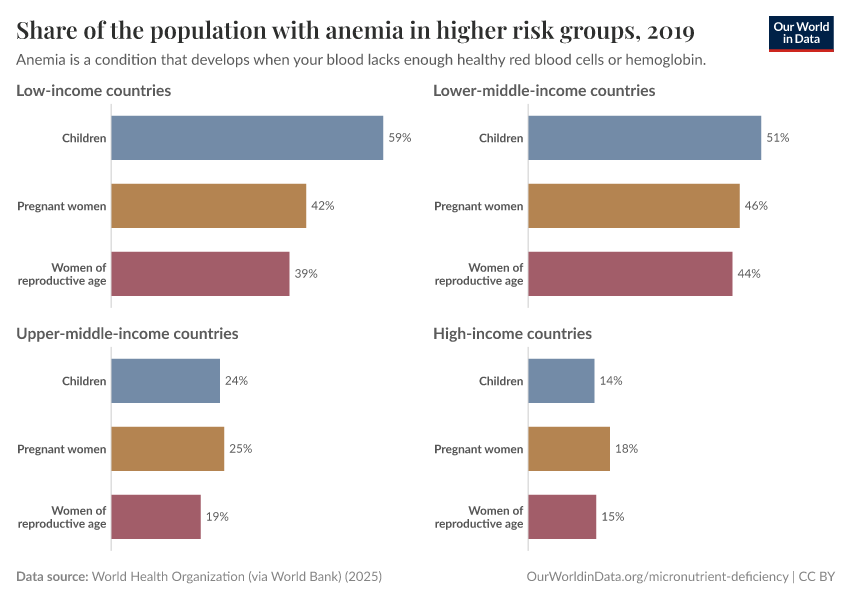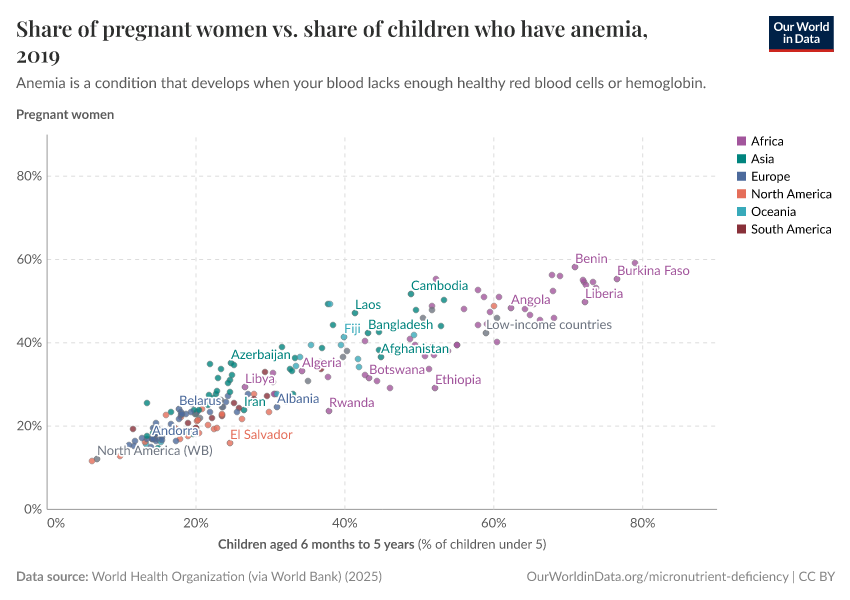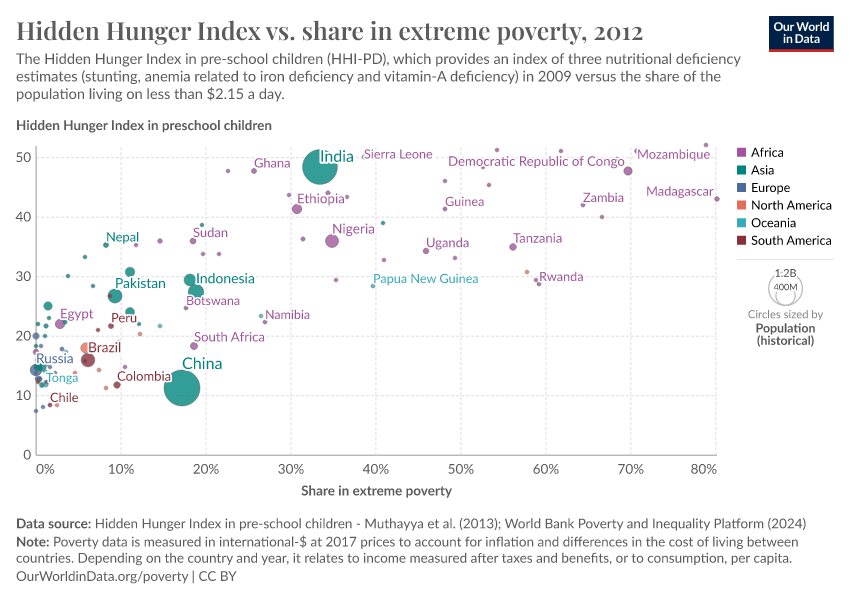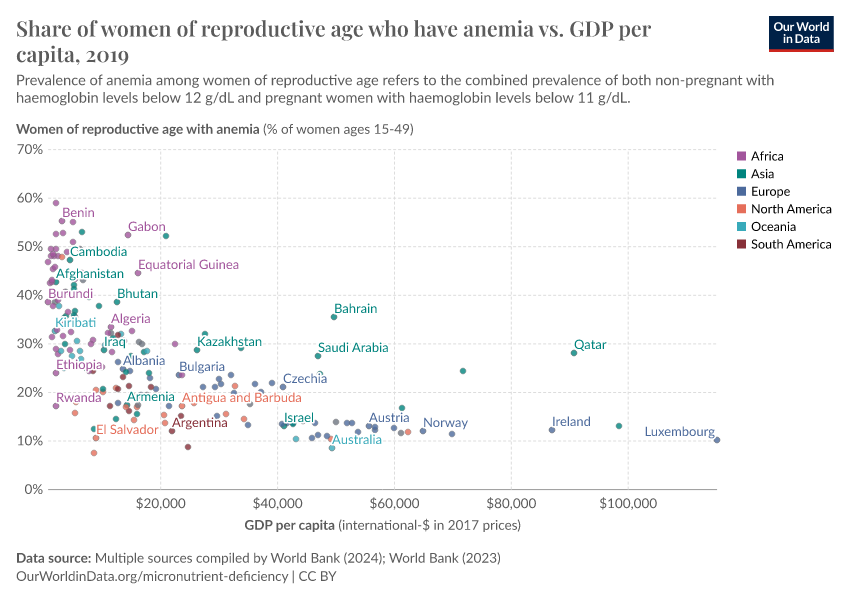Micronutrient Deficiency
Who is most affected by the "hidden hunger" of micronutrient deficiency?
This article was first published in August 2017.
Micronutrient deficiency is defined as a lack of essential vitamins and minerals that are required in small amounts by the body for proper growth and development.
In contrast to macronutrients — which include energy, protein, and fat — micronutrients are vitamins and minerals that are consumed in small quantities but are nonetheless essential for physical and mental development.
Essential micronutrients include, but are not limited to: iron, zinc, calcium, iodine, vitamin A, B vitamins, and vitamin C.
Deficiencies in these micronutrients are an important global health issue. They can result in poor physical and mental development in children, vulnerability or exacerbation of diseases, mental retardation, blindness, and general losses in productivity and potential.
Unlike energy-protein undernourishment, the health impacts of micronutrient deficiency are not always acutely visible. Micronutrient deficiency is therefore sometimes termed "hidden hunger", and the two terms are often used interchangeably.
Globally, it’s estimated that over half of children under five years old are micronutrient deficient (in at least one of iron, zinc, and vitamin A). In addition, over two-thirds of non-pregnant women of reproductive age are micronutrient deficient (in at least one of iron, zinc, and folate — also known as vitamin B9).1
This topic page explores global trends in key micronutrient deficiencies, potential health and development impacts, and progress in interventions to address vitamin and mineral deficiencies.
See all interactive charts on Micronutrient Deficiency ↓
Related topics:
Other research and writing on Micronutrient Deficiency on Our World in Data:
Pregnant women and young children are most vulnerable to micronutrient deficiency
Pregnant women and young children are at greatest risk of developing deficiencies, although any individual can experience micronutrient deficiency. This is not only because of low dietary intake, but also from higher physiological requirements — pregnancy and childhood development often increase demand for specific vitamins and minerals.
The nutritional status of a pregnant woman is not only relevant for her health, but can also have important consequences for her child’s development. Therefore, monitoring and addressing micronutrient deficiencies in both pregnant women and young children is essential for healthy development.
Data on deficiency prevalence, impacts, and intervention strategies therefore tend to be focused on pregnant women and young children. Much of the content that follows is therefore focused on (but not limited to) malnutrition in pregnant women and children under the age of five.
Anemia (iron or vitamin B12 deficiency)
Anemia is a condition in which an individual’s blood lacks enough red blood cells to carry oxygen efficiently around the body. Anemia can result from a lack of iron or vitamin B12, although iron deficiency is the most common type.
Anemia has important implications for general productivity and development, reducing people’s ability to work and perform daily activities. In more serious cases, anemia can exacerbate disease and illness. It is also responsible for a considerable share of maternal deaths.2
Anemia in pregnant women
In the chart, we see the prevalence of anemia in pregnant women. Globally, around a third of pregnant women worldwide are anemic.
The prevalence of anemia in pregnant women is typically lower in higher-income regions, being lowest in North America, and Europe & Central Asia. Rates are particularly high across South Asia and sub-Saharan Africa.

Anemia in women of reproductive age
In the chart, we see the prevalence of anemia in women of reproductive age.

Anemia in children
In the chart, we see the prevalence of anemia in children under the age of five.
Globally, around four-in-ten children have anemia.
Rates are lowest in North America, Europe & Central Asia, and East Asia & the Pacific, and highest in South Asia and sub-Saharan Africa.

Vitamin A deficiency
Vitamin A is a key nutrient for the development of embryos during pregnancy, the development of the immune system, and vision. It is found in many foods including green leafy vegetables, yellow vegetables and fruits, dairy products, fish, and eggs.3
Vitamin A deficiency is the leading cause of preventable blindness in children globally. It can begin as a milder form called "night blindness", and progress to permanent blindness in stronger cases.
Vitamin A deficiency also exacerbates serious disease and illness, leading to increased rates of maternal and childhood mortality.
Vitamin A deficiency in pregnant women
In the map, we see the prevalence of vitamin A deficiency in pregnant women, during the period from 1995 to 2005.
Data collection on micronutrient deficiencies is often sporadic and less consistent than indicators of energy-protein malnutrition — time-series data for most countries is therefore unavailable.
Prevalence rates are typically highest across Africa and Asia. The prevalence across Central Europe and Latin America is much lower, with a small share of pregnant women estimated to be deficient.

Night blindness in pregnant women
Vitamin A deficiency can, in some cases, result in visual impairment or blindness. In moderate form, this is limited to night blindness, but in severe cases, it can become permanent.
In the map, we see the prevalence of night blindness in pregnant women. Compared to the prevalence of vitamin A deficiency, these figures are lower — not all cases of deficiency result in night blindness.
The prevalence of night blindness in most countries is low. However, several countries across sub-Saharan Africa and South Asia record much higher rates.
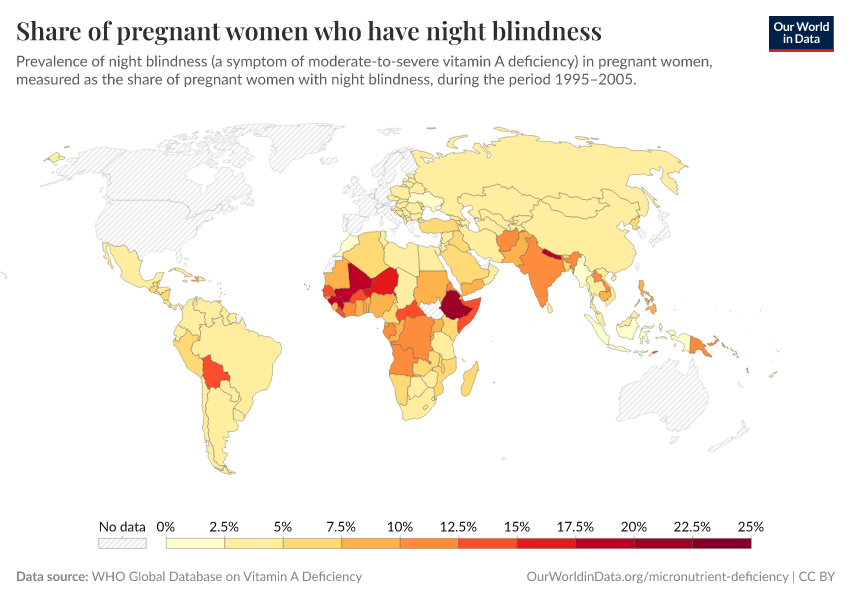
Vitamin A deficiency in children
In the map, we see the prevalence of vitamin A deficiency in children under the age of 5, during the period from 1995 to 2005.
Prevalence rates are typically highest across sub-Saharan Africa and South Asia — over half of children in many countries in these regions are deficient.
By 2005, the prevalence across Central Europe and Latin America is lower than in Africa and Asia, but still with a sizeable share of children deficient for vitamin A.

Night blindness in children
In the map, we see the prevalence of night blindness in children younger than 5 years old over the period 1995–2005.
The prevalence of night blindness is under 1 percent in many countries, but is much higher in some countries in central Africa and central Asia.

Zinc deficiency
Zinc is an essential nutrient for the immune system, and is used to make DNA and protein in our body. It is found in whole grains, beans, fortified cereals, meat, fish, poultry, and seafood.4
Zinc is needed for growth and recovery, and deficiencies can therefore stunt growth, increase susceptibility to disease and infection, and impair recovery, and is associated with higher mortality in mothers and newborns.5
Zinc deficiency can have several negative health consequences that affect many parts of the body, including the central nervous system, the skeleton, the digestive system, the immune system, and other systems.6
Globally, zinc deficiency is very common – particularly in lower-income countries where diets are cereal-dominant and typically lower in protein.
Zinc deficiency is prevalent in men, women, and children — in contrast to anemia, which is much more common in women.
In the chart below, we see the prevalence of zinc deficiency across the whole population.
In many high-income countries, under ten percent of the population have zinc deficiency.
Across sub-Saharan Africa and South Asia, the prevalence is much higher, with a sizable share of the population in many countries being deficient.

Hidden Hunger Index
Global Hidden Hunger Index in pre-school children
Since there are a range of micronutrient deficiencies and nutritional outcomes we can measure, it is difficult to distill the severity of micro-malnutrition into a single measure.
One metric that has been developed to indicate the severity of this is the Global Hidden Hunger Index (GHHI). Note that the terms "hidden hunger" and "micronutrient deficiency" are often used interchangeably. The GHHI is most commonly used to assess the nutritional status of preschool children (under the age of five).
The GHHI is calculated as the average of three nutritional indicators in preschool children: the prevalence of stunting (children who are too short for their age), anemia, and vitamin A deficiency.
In the map, we see national GHHI values during the period between 1999 and 2009.
Hidden Hunger is considered to be "alarmingly high" in several countries in sub-Saharan Africa and South Asia.
The remaining countries in these regions typically fall within the "moderate-to-severe" range. The majority of countries across Latin America, North Africa, Central Europe, and East Asia are defined as having "mild" hidden hunger issues.

Preventing and treating micronutrient deficiency
If micronutrient requirements cannot be met through dietary intake alone — for example, if households do not have access to, or cannot afford, the dietary diversity required to meet micronutrient requirements — then three other strategies can be used to address deficiencies.
These are supplementation, food fortification, and biofortification.7
- Supplementation is the use of concentrated micronutrients in pill, powder, or liquid form.
- Food fortification is when small amounts of micronutrients are added to common food products used by the general population, such as cereals, wheat flour, and rice.
- Biofortification is when agronomic and plant-breeding approaches in agriculture are used to increase the concentration of particular micronutrients in staple food crops. The most well-known example is the so-called "golden rice", which is rice grown with high concentrations of vitamin A.
Vitamin A supplementation
As covered earlier in this topic page, children under the age of 5 are typically the most vulnerable to vitamin A deficiency.
Many countries try to tackle this issue by providing vitamin A supplements to children, in the form of high-dose capsules several times per year.
In the map, we see the coverage rate of vitamin A supplementation in children aged between 6 months and 5 years.
Vitamin A supplementation is defined as being sufficient if a child receives at least two high-dose capsules per year.
Vitamin A supplementation is relatively common in many countries in Africa and South Asia, although some countries still have low rates of supplementation.

Iodized salt supply
Iodine deficiency is a major cause of preventable brain damage in childhood. It can result in stillbirths and the deaths of young infants, mental disability, and thyroid impairments.
In the mid-1980s, the world committed to ending global iodine deficiency.8
Iodine deficiency results from diets low in iodine, which is more common in places where soils have low iodine content, which reduces iodine concentrations in crops generally. Iodine deficiency is therefore hard to address simply through dietary diversification.
The global solution to addressing deficiency has been through Universal Salt Iodization (USI) programs. Salt is used as a delivery device for iodine for several reasons: it is widely consumed and has little seasonal variation, it is typically distributed from a few centralized production centers, it has little impact on the taste or texture of foods, and it is cheap.
In 2014, Universal Salt Iodization was estimated to cost US$0.02–0.05 per person per year.9
Since the WHO and UNICEF recommended Universal Salt Iodization to address iodine deficiency, the world has made significant progress.9
Many countries have eliminated iodine deficiency as a public health issue. But in some poor countries countries, iodine deficiency remains a health challenge.
In the map, we see the share of households consuming iodized salt from 1993-2013. Overall, we see that in many countries, a large share of the population consumes iodized salt.

Diarrhea treatment in children
Micronutrient deficiency can exacerbate existing diseases and illnesses, such as diarrheal diseases.
Around half a million children die annually from diarrheal diseases, which is more severe in children who are malnourished.
Malnutrition can exacerbate the risk of death from diarrhea. In addition, diarrhea affects the ability of children to retain and use nutrients sufficiently, which increases the requirements for nutrient intake.
Treating diarrheal disease is therefore an important global health issue.
The map below shows the share of children under the age of 5 who received diarrheal treatment in the form of oral rehydration salts.

Micronutrient deficiency is more prevalent in countries with poor dietary diversity
People need a diverse diet to ensure adequate micronutrient intake if they don’t consume fortified, processed foods.
Micronutrient-rich foods include fruit and vegetables, meat and dairy, pulses, seafood, nuts and seeds.
In contrast, cereal, root, and tuber commodities tend to be energy-dense but are micronutrient-poor.
In the chart, you can see the hidden hunger index in children versus the share of dietary energy attained through the consumption of cereals, roots, and tubers.
Overall, we see that countries where diets are higher in micronutrient-poor cereals also tend to have higher levels of micronutrient deficiency.
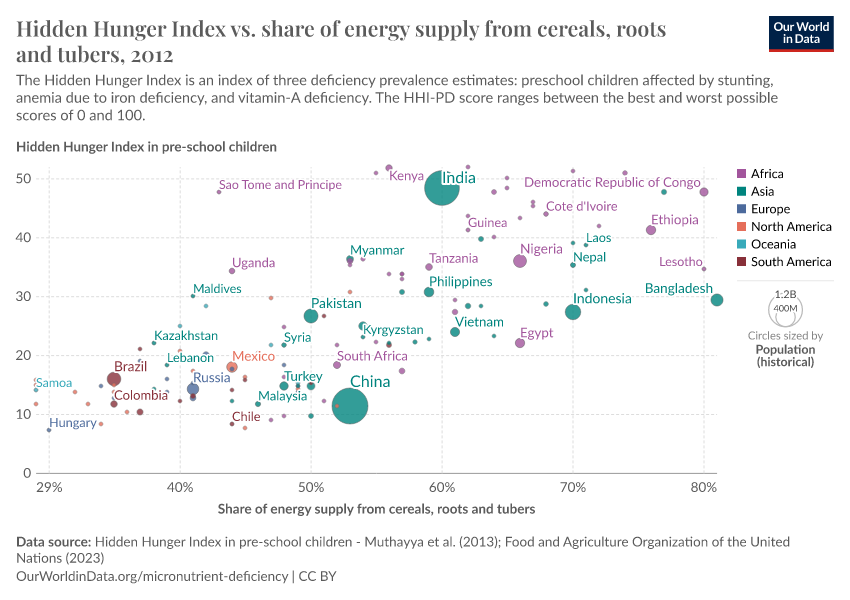
Micronutrient deficiency is more severe at lower incomes
The chart shows the Hidden Hunger Index in preschool children versus gross domestic product (GDP) per capita, measured in constant international dollars.
Overall, we see that countries with lower GDP per capita experience more severe deficiency and malnutrition issues in children. This is also true of other deficiency measures such as the prevalence of anemia in women of reproductive age.
Why is micronutrient deficiency more prominent among people of lower incomes?
Since cereals tend to be less expensive than other food commodities, poorer households tend to have a more monotonous and energy-dense diet that is lacking in the dietary diversity required to meet micronutrient requirements.10
In contrast, richer households are more able to afford a diverse range of micronutrient-rich foods to supplement staple food items.
Read more:
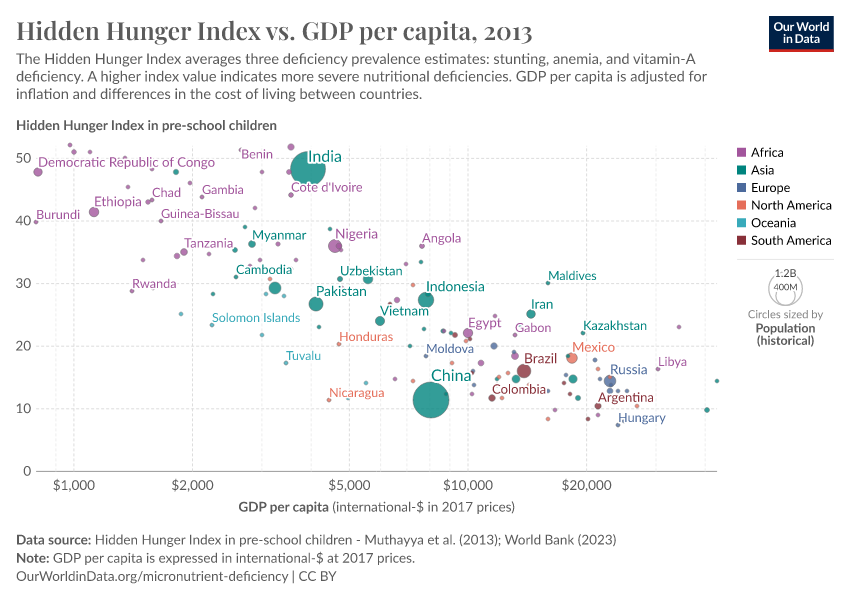
Key Charts on Micronutrient Deficiency
See all charts on this topicEndnotes
Stevens, G. A., Beal, T., Mbuya, M. N. N., Luo, H., Neufeld, L. M., Addo, O. Y., Adu-Afarwuah, S., Alayón, S., Bhutta, Z., Brown, K. H., Jefferds, M. E., Engle-Stone, R., Fawzi, W., Hess, S. Y., Johnston, R., Katz, J., Krasevec, J., McDonald, C. M., Mei, Z., … Young, M. F. (2022). Micronutrient deficiencies among preschool-aged children and women of reproductive age worldwide: A pooled analysis of individual-level data from population-representative surveys. The Lancet Global Health, 10(11), e1590–e1599. https://doi.org/10.1016/S2214-109X(22)00367-9
WHO. The global prevalence of anemia in 2011. Geneva: World Health Organization; 2015. Available online.
National Institutes of Health. Office of Dietary Supplements. (2022). Vitamin A and Carotenoids — Fact Sheet. https://ods.od.nih.gov/factsheets/VitaminA-Consumer/
National Institutes of Health. Office of Dietary Supplements. (2022). Zinc — Fact Sheet. https://ods.od.nih.gov/factsheets/Zinc-Consumer/
Prasad, A. S. (2013). Discovery of Human Zinc Deficiency: Its Impact on Human Health and Disease–. Advances in Nutrition, 4(2), 176-190. Available at: https://academic.oup.com/advances/article/4/2/176/4591626 .
Jurowski, K., Szewczyk, B., Nowak, G., & Piekoszewski, W. (2014). Biological consequences of zinc deficiency in the pathomechanisms of selected diseases. JBIC Journal of Biological Inorganic Chemistry, 19(7), 1069-1079. Available at: https://www.ncbi.nlm.nih.gov/pmc/articles/PMC4175048/
Miller, D. D., & Welch, R. M. (2013). Food system strategies for preventing micronutrient malnutrition. Food Policy, 42, 115-128. Available online.
World Health Organization (2004). Iodine status worldwide. WHO Global Database on Iodine Deficiency. Available online.
WHO. Guideline: fortification of food-grade salt with iodine for the prevention and control of iodine deficiency disorders. Geneva: World Health Organization; 2014. Available online.
Allen, L. H., De Benoist, B., Dary, O., Hurrell, R., & World Health Organization. (2006). Guidelines on food fortification with micronutrients. Available online.
Cite this work
Our articles and data visualizations rely on work from many different people and organizations. When citing this topic page, please also cite the underlying data sources. This topic page can be cited as:
Hannah Ritchie and Max Roser (2017) - “Micronutrient Deficiency” Published online at OurWorldinData.org. Retrieved from: 'https://ourworldindata.org/micronutrient-deficiency' [Online Resource]BibTeX citation
@article{owid-micronutrient-deficiency,
author = {Hannah Ritchie and Max Roser},
title = {Micronutrient Deficiency},
journal = {Our World in Data},
year = {2017},
note = {https://ourworldindata.org/micronutrient-deficiency}
}Reuse this work freely
All visualizations, data, and code produced by Our World in Data are completely open access under the Creative Commons BY license. You have the permission to use, distribute, and reproduce these in any medium, provided the source and authors are credited.
The data produced by third parties and made available by Our World in Data is subject to the license terms from the original third-party authors. We will always indicate the original source of the data in our documentation, so you should always check the license of any such third-party data before use and redistribution.
All of our charts can be embedded in any site.
